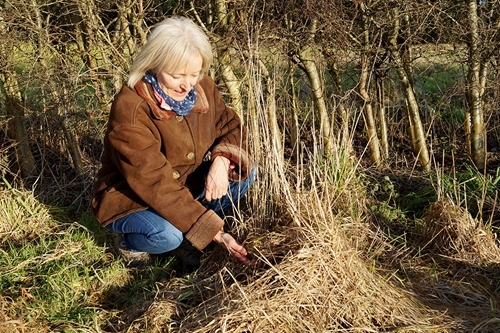By Joe Dimbleby
 The Rotherfield Demonstration Project is part of the Selborne Landscape Partnership, one of 98 Farmer Clusters in the UK. I recently went to interview Kate Faulkner from neighbouring Norton Farm, another member of the Cluster, and she explained how valuable having Rotherfield in the group has been.
The Rotherfield Demonstration Project is part of the Selborne Landscape Partnership, one of 98 Farmer Clusters in the UK. I recently went to interview Kate Faulkner from neighbouring Norton Farm, another member of the Cluster, and she explained how valuable having Rotherfield in the group has been.
“Rotherfield Park is trail blazing with their seed mix trials and we’ve been on numerous farm walks there to learn more about conservation management,” she said. “In addition, GWCT’s senior conservation scientist Francis Buner attends all our meetings and visits the individual farms in the group to give advice. Rotherfield really is a gold-standard showcase, so when Francis came out to us last November I thought his suggestions for our farm might be over the top, but they were actually very achievable. As a result, we are modifying our conservation measures to achieve more for wildlife.”
For one of its first projects, the Selborne Landscape Partnership chose to improve habitat for harvest mice, inspired by the famous 18th Century naturalist Gilbert White. White lived in nearby Selborne and identified the harvest mouse as a separate species. In 1999, only one harvest mouse nest was recorded around the village of Selborne, so after receiving tuition from GWCT advisor Peter Thompson and Francesca Pella (a harvest mouse expert living on the Rotherfield estate), several teams from the farms went out in the winter of 2014/2015 and counted 472 separate nests across the Cluster, coordinated by Rob Nicholls from the South Downs National Park.

Kate said: “Walking in the countryside and having things pointed out by knowledgeable experts such as Francis and Peter, and attending their talks, is inspiring. As well as advice on management, they have taught us so much about how to read the landscape for wildlife. I’m a big fan of the GWCT. Their advisors are very practical and can see things from a farming perspective. A collaborative approach is far more appealing than being dictated to.”
 Inspired by the project, the Faulkners decided to improve their hedgerows. One ten-year-old hawthorn hedge was straggly at the bottom and was letting the wind through at the base, so, in an example of collaboration, they invited Rob to organise a weekend’s training for farmers to learn how to cut and lay the hedges to provide better nesting habitat for harvest mice. If you do something for one species, it often helps others. In this case whitethroats and yellowhammers, which nest low down in hedgerows, now benefit from increased insect life and protection from predators.
Inspired by the project, the Faulkners decided to improve their hedgerows. One ten-year-old hawthorn hedge was straggly at the bottom and was letting the wind through at the base, so, in an example of collaboration, they invited Rob to organise a weekend’s training for farmers to learn how to cut and lay the hedges to provide better nesting habitat for harvest mice. If you do something for one species, it often helps others. In this case whitethroats and yellowhammers, which nest low down in hedgerows, now benefit from increased insect life and protection from predators.
Looking ahead, along with the rest of the Cluster, Norton Farm is planning to cut and lay more hedges and incorporate a supplementary feeding stewardship option where grain is spread for birds during winter months, something trialled at Rotherfield but not yet tried on a landscape scale. With guidance from Francis, they will be learning how to do an official hare count, which will help the preservation of the species in the area, and are also working with Rotherfield to boost lapwings, the rare Duke of Burgundy and brown hairstreak butterflies and, of course, harvest mice.
Kate’s advice for fellow farming conservationists: “It helps to collaborate, to talk to your neighbours and to get guidance from the GWCT. It’s to do with getting advice from people who talk the same language and understand the realities of farming.”
Working conservationists
Kate was interviewed as part of a new collection of case studies of conservation-minded farmers, landowners and gamekeepers from across the UK, to be published this year. It is intended to better understand what lies behind their successes, what inspires them and what more can be done to support them. The profiles make a strong case for the continuation of subsidies for farmers in exchange for environmental goods and the vital part played by the GWCT both in providing the science behind stewardship schemes and the practical advice on how best to implement them.
If you are managing to achieve the multiple outcomes of farming or shooting and conservation or know someone who is, please contact Joe Dimbleby at jdimbleby@gwct.org.uk.